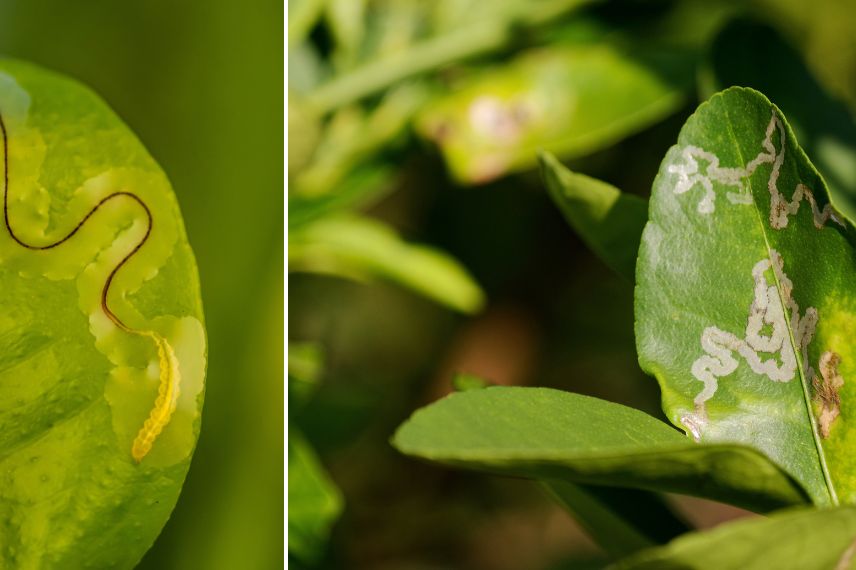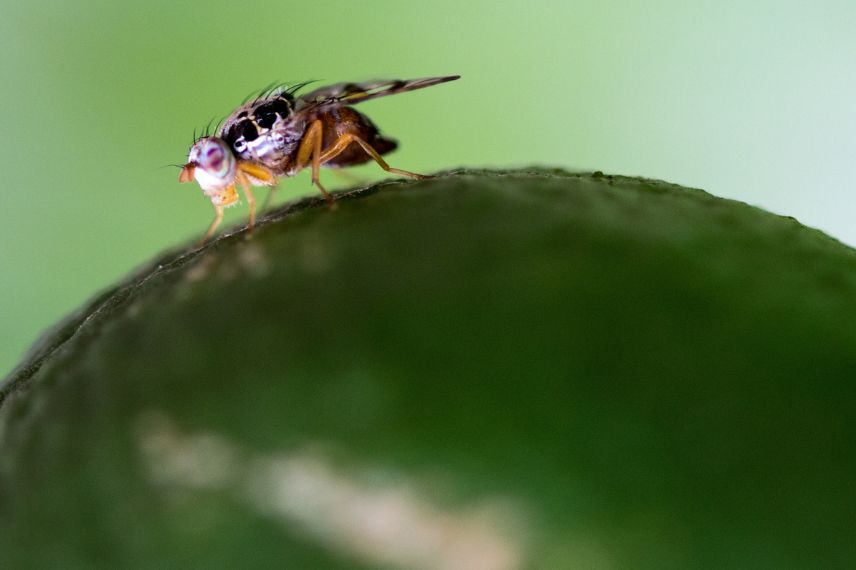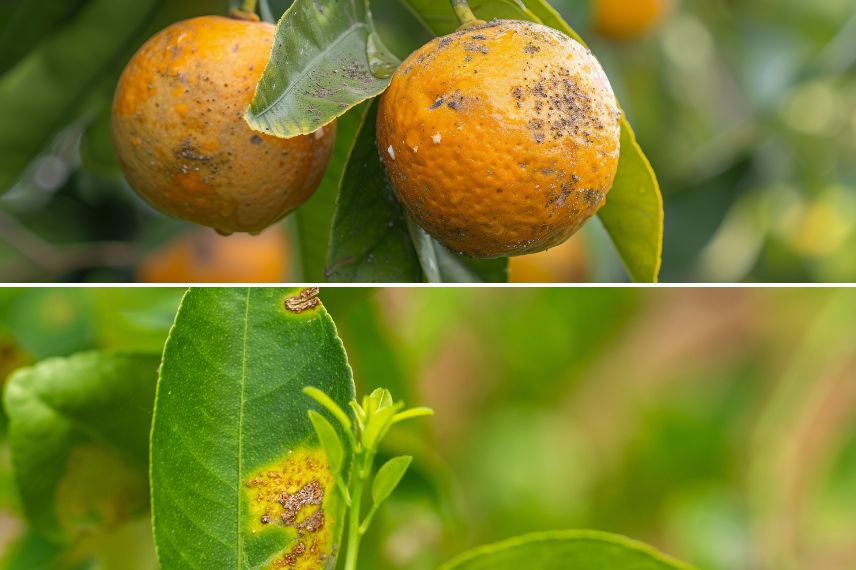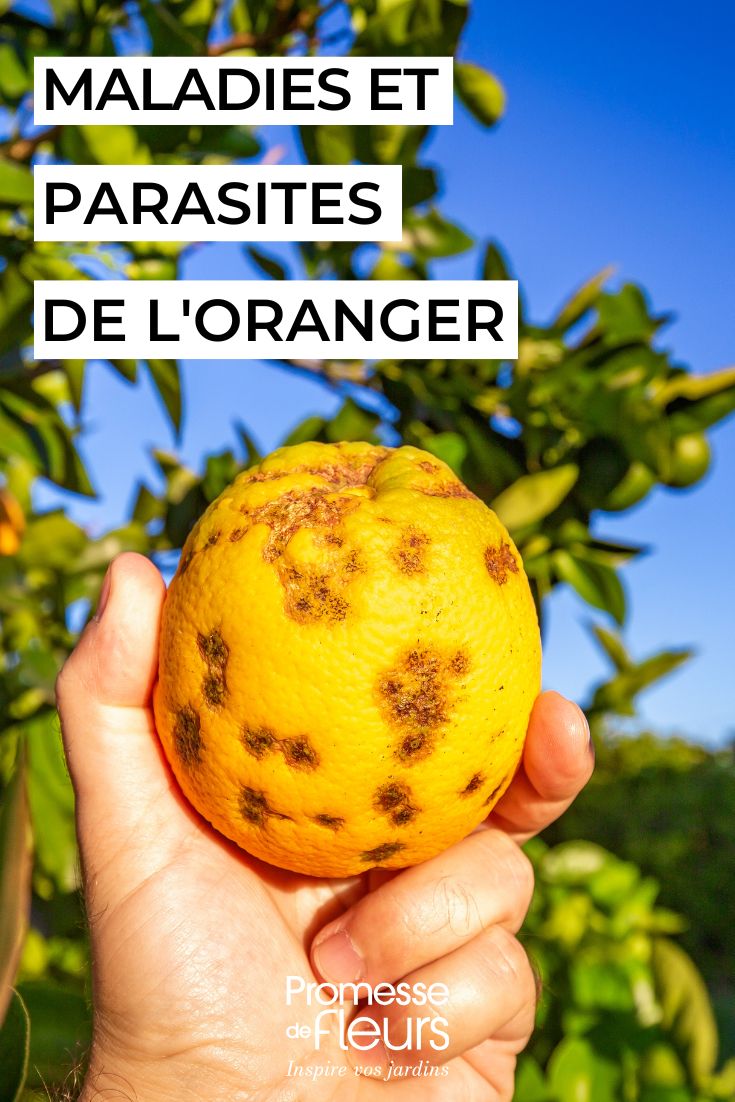
Orange tree: how to identify and treat its diseases and parasitic?
Tips for recognising, treating, and preventing diseases and pests of orange trees
Contents
The orange tree (Citrus sinensis) forms a beautiful fruit tree with a harmonious silhouette, valued for its fragrant flowering and large, tasty, juicy fruits. Particularly sensitive to cold, it is only grown in open ground around the Mediterranean. Elsewhere, it adapts very well to container cultivation, allowing it to enjoy the sun in summer and winter in a warm environment, ideally in a conservatory, an unheated greenhouse, or a winter garden. With suitable growing conditions, your orange tree can be productive. However, at the slightest misstep, it can be susceptible to numerous diseases, not to mention the pests that take advantage of any weakness to settle in.
Discover the main fungal diseases and pests that the orange tree may face and how to address them.
To go further: Lemon trees, orange trees, and other citrus trees: how to plant and cultivate them in pots or in the garden.
What are the most common pests of the orange tree?
Like many fruit trees, the orange tree attracts its share of unwanted little visitors. These pests, often tiny, can cause significant damage if not detected and treated in time. This is especially true if you are growing your orange tree in a pot. In winter, when it is confined in a greenhouse or conservatory, it is relatively susceptible to insect attacks. However, orange trees grown in open ground are not exempt from diseases.
Aphids
These are certainly the most common pests on orange trees. These small soft-bodied insects, most often black or green, pierce the leaves, particularly the young shoots, and suck the sap. They secrete honeydew, which ants feed on.
- Symptoms: the leaves of the orange tree curl, deform, and turn yellow; flower buds abort; growth is weakened, and there is a risk of sooty mould appearing.
- Treatment: a spray of garlic decoction or a mixture of black soap and water, possibly supplemented with vegetable oil, is often sufficient to get rid of these intruders. You can also introduce ladybird larvae or green lacewings. In case of severe infestation, a natural insecticide based on plant pyrethrum may be necessary.
- Prevention: regular monitoring of the orange tree allows for quick action.
Scale Insects
The other feared pest of the orange tree is the scale insect, another piercing-sucking insect that feeds on the sap of the tree’s tissues. It appears as small white, brown, or cottony shields attached to the stems and leaves, usually on the underside or in the axil. Scale insects thrive particularly in warm and humid environments.
- Symptoms: the leaves of the orange tree curl, and entire branches eventually dry out.
- Treatment: orange trees grown in open ground can be watered with a powerful jet of water that will dislodge the scale insects. For potted orange trees, you can initially scrape the infested areas with a cotton swab dipped in 90°C alcohol, then spray a solution of black soap and vegetable oil in one litre of water.
- Prevention: once again, systematic monitoring of your tree will allow you to intervene quickly. Also, remember to ventilate your greenhouse or conservatory.
Citrus Leaf Miner
The citrus leaf miner (Phyllocnistis citrella) is a nocturnal moth, silver-white in colour, that gives rise to yellowish larvae. These larvae attack the leaves, where they tunnel out galleries known as mines in a serpentine shape. This butterfly appears in April, and several generations can succeed each other in one season. The citrus leaf miner primarily attacks orange trees in open ground, in the Mediterranean region and Corsica.
- Symptoms: the leaves are marked with mines that are silver in outline, then black. The leaves curl, dry out, and fall off. The growth of the orange trees is slowed.
- Treatment: there is no effective treatment to eliminate this insect, but pheromone traps can capture males and thus limit mating. Otherwise, as soon as a leaf is visibly attacked, it is recommended to remove it.
 Symptoms of the presence of the citrus leaf miner
Symptoms of the presence of the citrus leaf miner
Mediterranean Fruit Fly
When the orange tree bears fruit, one must beware of the Mediterranean fruit fly (Ceratitis capitata), which lays its eggs beneath the epidermis of the fruits. As soon as they hatch, the larvae tunnel into the oranges and feed on the pulp, rendering the fruits inedible.
- Symptoms: The oranges are punctured and maggoty, thus inedible.
- Treatment: regular collection of fallen fruits and pheromone traps to capture males remain the most effective means of treatment and prevention.
 Mediterranean fruit fly
Mediterranean fruit fly
Read also
Aphid: identification and treatmentHow to identify and treat the most common diseases in orange trees?
Some diseases are more common among fruit growers, but your orange tree in the ground, less often in a pot, can be affected. It is worth noting that the yellow dragon disease (Huanglongbing or Citrus greening), which is formidable for citrus crops, is only present in Asia, America, and Africa, but not yet in Europe.
Gummosis caused by Phytophtora
This is a serious and dreaded disease caused by the fungi Phytophtora citrophtira or Phytophtora parasitica, which affects the trunk and roots of the orange tree, particularly at the base of the tree. This condition is often caused by excess moisture or poor planting conditions, such as poorly drained soil.
- Symptoms: this fungal disease manifests as amber gum exudates, sometimes accompanied by scaly cracks in the bark. The tree then shows signs of general weakness with yellowing of the leaves, drying of the branches, rotting of the fruits, and slowed growth.
- Treatment: in case of infection, pruning and/or cleaning of the affected parts and the application of a natural fungicide such as Bordeaux mixture can help contain natural spread.
- Prevention: it is essential to ensure good soil drainage and to avoid any injury at the collar. Likewise, regular pruning should be carried out to remove diseased branches, followed by the application of a healing mastic.
Sooty mould
Sooty mould is a direct consequence of the presence of aphids or scale insects. A black fungus develops on the honeydew, forming a sooty layer on the leaves and stems. It blocks photosynthesis.
- Symptoms: the leaves are sticky, then they turn yellow. Growth is slowed, and the tree becomes unsightly.
- Treatment: this primarily involves eliminating the responsible pests. Then, a simple wash with clear water or a little black soap often helps to remove the black layer.
Citrus canker
Sometimes called citric canker, this disease is caused by the bacterium Xanthomonas citri. It is particularly severe and spreads very quickly through water splashes, contaminated tools, or insects. It affects leaves, fruits, and branches.
- Symptoms: brownish, slightly sunken spots on the leaves, branches, and fruits. These lesions are often bordered by a yellow halo. Leaves drop, and fruits deform and also fall prematurely.
- Treatment: Control involves removing the affected parts and possibly eliminating severely affected trees to prevent contamination of the rest of the orchard.
- Prevention: it is preferable to avoid overhead watering. Orange trees can also be protected from the wind, and it is essential to use well-disinfected tools.

Dry disease (mal secco)
This is a fungal disease caused by the fungus Phoma tracheiphila that affects the leaves, branches, and even the entire tree.
- Symptoms: leaves discolour, starting with the veins, then they wilt and dry. Branches decline. When cut, an orange coloration is seen in the wood. In the most severe cases, the orange tree dies.
- Treatment and prevention: there is no effective treatment, so all measures must focus on prophylactic actions such as disinfecting tools, pruning, and working the soil in dry weather, and preventing injuries.
Citrus brown rot
Brown rot is a fungal disease caused by the fungus Monilinia that primarily attacks the fruits. It is a disease of humid climates.
- Symptoms: oranges develop brown spots covered with white mould. Leaves yellow and drop prematurely.
- Prevention: it is essential, as treatments are ineffective and difficult to implement on fruits. Prevention involves caring for tree wounds with mastic, limiting humidity, removing mummified fruits, and pruning infected parts.
Tristeza virus
This virus, primarily spread by the brown citrus aphid, is particularly formidable. It attacks the vascular tissues of the tree, disrupting the flow of sap.
- Symptoms: leaves and fruits become stunted and deformed, they may show mottling, cracks appear on the trunk, the tree weakens and dies.
- Treatment and prevention: there is no curative treatment once the virus is established. The best strategy remains prevention, particularly through the choice of resistant rootstocks and careful monitoring to quickly detect aphids and limit their presence. Finally, diseased trees must be felled.
Prevention and good cultural practices
By adopting a few simple gestures in the garden, it is possible to avoid most diseases and significantly limit pest invasions. Here are the good practices to adopt daily:
- Soil maintenance and controlled watering: A well-drained soil, neither too dry nor too waterlogged, is essential. Using organic mulch (such as shredded material or fallen leaves) helps retain moisture without excess. For watering, it is better to water less frequently but deeply, especially during hot periods.
- Regular pruning and aeration of the branches: Pruning promotes air circulation and light penetration, two factors that naturally hinder the development of fungi. It also limits areas where pests can hide. A gentle pruning should be prioritised at the end of winter or the beginning of spring, and do not forget to disinfect tools before and after each use.
- Monitoring and early detection: A regular walk around an orange tree allows for early detection of the first signs of attack.
- Use of natural treatments: If needed, there are plenty of natural solutions: black soap against aphids and scale insects, nettle extract or horsetail extract to strengthen the tree’s defences… These gentle remedies respect the garden’s ecosystem while being remarkably effective when used correctly.
- Subscribe!
- Contents
































Comments